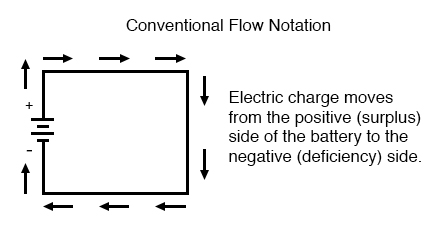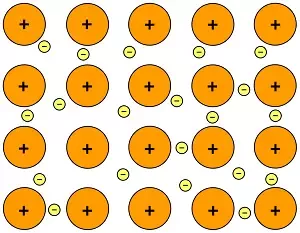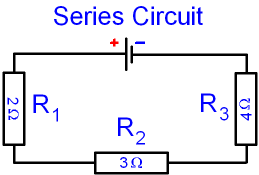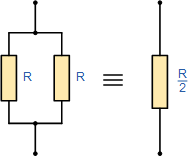Physics AS
Introduction Physical Quantities & Base units Vectors & Scalars Kinematics Pressure & Density Dynamics Momentum Energy, power & efficiency Deformation of solids Waves Superposition Stationary waves Electric fields Electricity Circuits & Kirchoff's laws Radioactive Physics AS PracticalPaper 5More
Reference Pastpaper QuestionsVoltage, Current, Resistance & More
Current
The rate of flow of electric charge past a point
So whenever a charge moves from one place to another there is always a current produced. So the charge could either be positive or negative.
Current = charge/time
I = Q/t
So 1 Coloumb of charge is passed a point when a circuit of 1A is switched on 1 Sec
Current is a base quantity which has a unit of ampere
So if we know how many charges are passing a point per second we can find the current
But you need to note this!
The smallest unit of charge is called e which has a magnitude of 1.6*10-19C. This could be an electron or a positive charge
e = 1.6*10-19C
This is known as the elementary charge as this is the smallest magnitude of charge which can exist on its own. You need to remember this value.
So all other total charges must be a multiple of e
Charge = N*e
For example, a charge of 2.6*10-19C does not exist as n would be not a whole number.
However, a charge of 4.8*10-19C is possible as it takes 3 elementary charge particles to give this charge
So there is another indirect equation for current
Current = Ne/t
So in ciruits, we always have electrons moving which has a charge of -e
So some questions will ask the total number of electrons passing a point and so they will give the current and the total time
Q = It
This will give us the total charge passed a point and we know the total charge is a multiple of e
Number of electrons(N) = Total charge / e
+e and -e
So what is -e ? These are known as particles which have a charge of -1.6*10-19C. This is actually an electron and so it is negatively charged
So what is +e? These are known as particles which have a charge of +1.6*10-19C. This is actually known as a proton or a positive ion
So usually if you have a charge of +10e, It means you have 10*1.6*10-19C = 1.6*10-18C
Conventional current
So the standard way of defining the direction of current is the flow of positive charge, and not negative charge

So for example if we have a circuit as above, current should move from + to - . As the positive charge is repelled from the positive terminal and attracted towards the negative terminal. But this is not the case. So by definition current flows from + to -, but, in a circuit positive charges can't flow. It's the delocalised electron which flows in the metal or the conductor
Electrons are negative and it actually moves the opposite direction of current(from - to +)
This is because conventional current is defined for positive current
Structure of a conductor

You will need to know some new terms
- Conduction electrons
- Number density
- Mean drift velocity
- Series
- parallel
- Current in a series remains the same everywhere.
- Current in a parallel splits
- Voltage splits in series, depending on the individual resistance
- Voltage remains the same in parallel circuits
As you see in the metallic bonding, the structure contains free moving/delocalised electrons which are called conduction electrons
So When you have more electrons obviously the current would be greater as more number of charges will be moving per sec
This is actually the number of conduction electrons per unit volume
Number density = Number of conduction electrons / volume
Remember n is not N
The average velocity of the moving conduction electrons
I = nAve
So now we will find another equation of current which is actually derived
Current = Number density * Area * Mean drift velocity * Elementary charge
I = nAvq
So the q is actually the magnitude of a single charge of a particle but, as this equation is mainly used in wires we use:
I = nAve
where e is 1.6*10-19C.
However, this equation could be used in any situation for example the ions in an electrolyte
Derivation
This is important as it helps you to recall the equation when you forget
So we know the Number Density * Volume would give us the number of conduction electrons
Number density = Number of conduction electrons / volume
Number of Conduction electrons = Number density * Volume
And we know Volume is area * height
So multiplying Number density with area give us the number of conduction electrons per meter
E per meter = Number density * Area
Then we multiply it by the velocity(distance moved per sec)
So now this gives us the number of conduction electrons per unit time
Conduction electron per unit time = nAv
As each electron has a charge of e, we multiply it to get the total charge moved per unit time
Total charge per unit time = nAve
Which is the same as current as:
I = Q/t
Relationships
Using this equation, we can show how one factor affects current or another factor
I = nAve
I ∝ n
When Number density increases, this means there are more electrons per unit volume so more charge can be carried per unit time
This is why metals are good conductors as the have a high number of n
In fact, the number Density is actually a constant for a particular material at a particular temperature. So Area and the mean drift velocity determines the current
I ∝ A
Greater area means more charges can flow and also less resistance
I ∝ v
Faster they move, the more charges pass per unit time
n ∝ 1/v
As n is usually a constant, greater n for the same current means that the drift velocity is less because, there are more electrons so it's harder to move. Think of a traffic road!
A ∝ 1/v
Greater the area, the slower the electrons move. Think of a river flowing! If it passes through a narrow pipe and if it were to transport the same amount of water, the water needs to travel fast
Voltage
The general idea is that work is done per unit change or there is a change in potential energy for carrying a unit charge
Remember the current and voltage has the same direction. This is because, voltage flows from the most potential to the least potential. This idea is needed in order to calculate the potential difference
Electromotive force EMF
This is not a force but, a specific term under voltage
The energy transformed by a cell from chemical to electrical energy in carrying a unit charge across the complete circuit
Emf = Workdone/Charge
V = W/Q
Just notice this is the complete energy provided by the battery and so emf is the total voltage provided by the battery
Also when electrons are moved from the negative terminal to the positve terminal, energy is released and so the energy must be used up and converted to other forms of energy, this is known as p.d
Potential difference
The energy transformed from electric to other forms of energy when driving a unit charge between two points in a circuit
P.d = Workdone/Charge
This work done is more specific and is the work done by a component such as a bulb
By assumption, wires don't carry any resistance. So no work is done against it and lost in the form of heat
There is an important point to recognise that the direction matters. For example, at the start of the circuit the potential (voltage) is almost same as the EMF 10v ( Assuming no internal resistance ). So the voltage before passing through the component has a electron potential of 10 v and the component has a p.d of 2v. The voltage after the component will be 8v. This idea of conserving energy as the energy lost 2J/c reduce the potential energy by 2J for each unit of charge
And the total energy of the battery must be eventually converted to other forms of energy
EMF = Total P.d
Resistance
It is the potential difference per unit current
SI units: Ohms Ω
Resistance = Voltage/Current
Resistance is applied in different situations. For example, the resistance of the whole circuit would be the Total voltage/Total current. Or it could be the resistance of a component which is the Potential difference across that component per unit current
We will state the equation used to find the resistance of a component
Resistance = P.D / current
Why is there resistance? As electrons flow through the haphazard journey, they collide with vibrating cations and electrons and so they lose energy and release heat energy
Resistance is usually fixed for a component but, changes with length and other factors
How to calculate resistance in:
We just add the resistance together!

RTotal = R1+ R2 +..
2Ω + 3Ω +4Ω = 9Ω

1/Rtotal = 1/R1 + 1/R2 + 1/R3
Don't forget that after finding the total of the reciprocals, we need to find the reciprocal at the end.
Power
Power = Energy/time
We can find power in terms of V and I
Power = Voltage * Current
P = VI
There is another equation in terms of I and R only
Power = I2R
And only in terms of V and R
Power = V2/R
You need to know all these equations as they might ask to find the ratio of power between two objects
For example, they might say the power is the same. What is the ratio between the Rx/Ry?
V2x/Rx = V2y/Ry
V2x/V2y = Rx/Ry
Watch out that the We MUST use V2x and not Vx
Current in a ciruit
So how do we find the current around the circuit. We need to some things:
Why? Think about it. The battery pumps out a certain amount of electrons and also it collects the electrons at the positive terminal. So electrons given must equal to the electrons collected. And this is must be the same rate. So the current remains the same at the point it is given out by the battery and at the point taken in by the battery.
So all the components in the circuit has the same current. If they are in series only.
This idea is very simple. When there are two or more paths available, the current splits and it depends on the resistance. More current always flows through the path which has the lowest resistance
But Remember this! When the parallel circuit joins to the main circuit again, the current must be the same as what was entered - this is known as Kirchoff's first law
Voltage in a circuit
We also need to know some basics
Why? When charge passes through a circuit it loses energy.
So we need to know that when you have more resistance, the greater potential difference it takes
Vout = Vin * R1/ R1+R2
So this is actually a ratio of a particular resistance compared to the total resistance of the circuit
R1/ R1+R2
This gives us a good relationship that when Resistance increases so does the P.D - Remember this by no means!
Voltage ∝ Resistance
This idea confuses many but, there is a simple way to tackle this. We Know that at the start of the circuit the potential is the Emf and as there are components, the potential decreases
Now in parallel, 2 or more wires are connected to the same point so they both have the same starting potentials and also ends at the same point. So as the potential difference is the same, they must have the same voltage
Most of the time, Wires do not have any resistance and so adding wires to the same point does not change the potential of the wire.
This idea must be fully understood as it is a basis used in many questions and concepts - such as the bridge wheatstone concept
Resistivity
It is the resistance of a particular material of unit length and unit cross-sectional area at a standard temperature
SI units: Ωm
So this is actually unique for a particular material at a constant temperature.
We know that resistance increases when the length of the material increases.
R ∝ L
We know that when the cross-sectional area increases, the resistance decrease. Why? Because more area means greater charge can pass through per unit time
R ∝ 1/A
So we combine to form:
R ∝ L/A
So we can add a constant, which is called resistivity
Resistance = Resistivity * Length / Area
R = PL/A
So we can find the value of resistivity of a material
P = RA/L
Remember that resistivity is a constant just like young modulus and Number density
Resistivity and Number density
There is a clear link between the number density of a material and its resistivity
P ∝ 1/n
As there is more conduction electrons per unit volume, it can carry more current and we know when current increases, resistance decreases
There is also two thing you need to remember:
Impure metals always have a higher resistivity but, they also follow the equation. Also the resistivity of a material increases with the temperature
Resistivity ∝ Temperature

MCQ techniques
There are some fast methods to solve some questions.

This shows that if we have two identical resistors, the combined resistance is always half of one of the resistor value
But also this applies for any number of identical resistors in a parallel circuit
Resistancecombined = Resistance of a resistor/Number of resistors
Rcombined = R/n
Recommended
These are things you might like. Clicking these ads can help us improve our free services in the future...
End of Chapter Videos
Collection of Videos to Support Your Understanding.
Remember these videos are handpicked by me and I feel these are the best ones out there. But I constantly update this list for each chapter. The Youtubers are more than welcome to contact me.
Also, don't forget to Subscribe to our Youtube channel - MrWik
Watch
